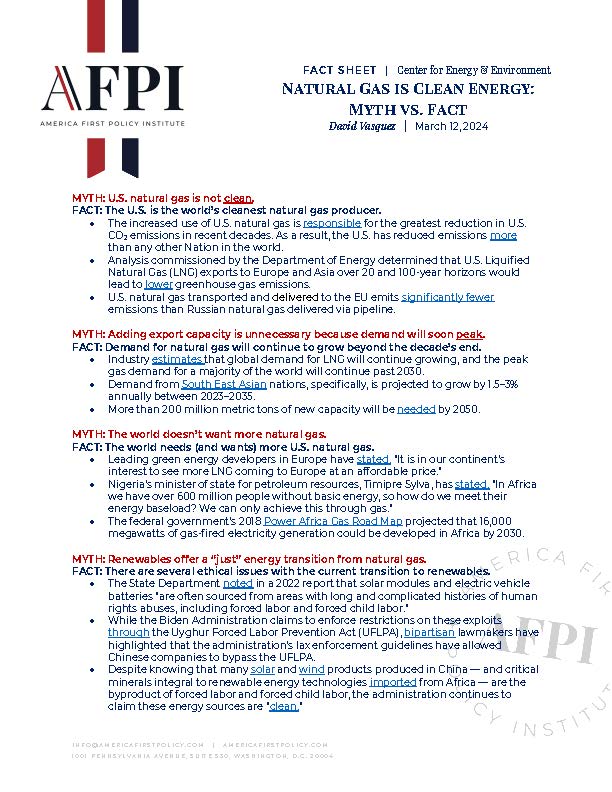David Vasquez ,
March 12, 2024
Natural Gas is Clean Energy: Myth vs. Fact
MYTH: U.S. natural gas is not clean.
FACT: The U.S. is the world’s cleanest natural gas producer.
- The increased use of U.S. natural gas is responsible for the greatest reduction in U.S. CO2 emissions in recent decades. As a result, the U.S. has reduced emissions more than any other Nation in the world.
- Analysis commissioned by the Department of Energy determined that U.S. Liquified Natural Gas (LNG) exports to Europe and Asia over 20 and 100-year horizons would lead to lower greenhouse gas emissions.
- U.S. natural gas transported and delivered to the EU emits significantly fewer emissions than Russian natural gas delivered via pipeline.
MYTH: Adding export capacity is unnecessary because demand will soon peak.
FACT: Demand for natural gas will continue to grow beyond the decade’s end.
- Industry estimates that global demand for LNG will continue growing, and the peak gas demand for a majority of the world will continue past 2030.
- Demand from South East Asian nations, specifically, is projected to grow by 1.5–3% annually between 2023–2035.
- More than 200 million metric tons of new capacity will be needed by 2050.
MYTH: The world doesn’t want more natural gas.
FACT: The world needs (and wants) more U.S. natural gas.
- Leading green energy developers in Europe have stated, “It is in our continent’s interest to see more LNG coming to Europe at an affordable price.”
- Nigeria’s minister of state for petroleum resources, Timipre Sylva, has stated, “In Africa we have over 600 million people without basic energy, so how do we meet their energy baseload? We can only achieve this through gas.”
- The federal government’s 2018 Power Africa Gas Road Map projected that 16,000 megawatts of gas-fired electricity generation could be developed in Africa by 2030.
MYTH: Renewables offer a “just” energy transition from natural gas.
FACT: There are several ethical issues with the current transition to renewables.
- The State Department noted in a 2022 report that solar modules and electric vehicle batteries “are often sourced from areas with long and complicated histories of human rights abuses, including forced labor and forced child labor.”
- While the Biden Administration claims to enforce restrictions on these exploits through the Uyghur Forced Labor Prevention Act (UFLPA), bipartisan lawmakers have highlighted that the administration’s lax enforcement guidelines have allowed Chinese companies to bypass the UFLPA.
- Despite knowing that many solar and wind products produced in China — and critical minerals integral to renewable energy technologies imported from Africa — are the byproduct of forced labor and forced child labor, the administration continues to claim these energy sources are “clean.”
